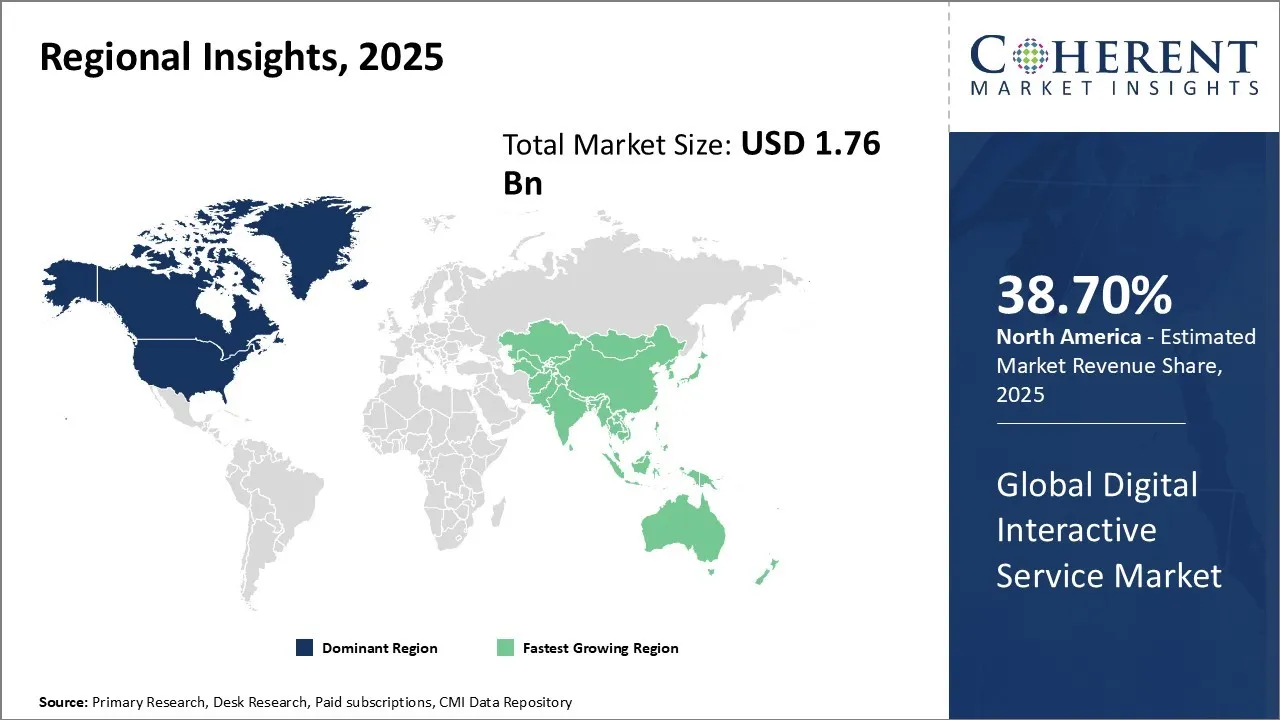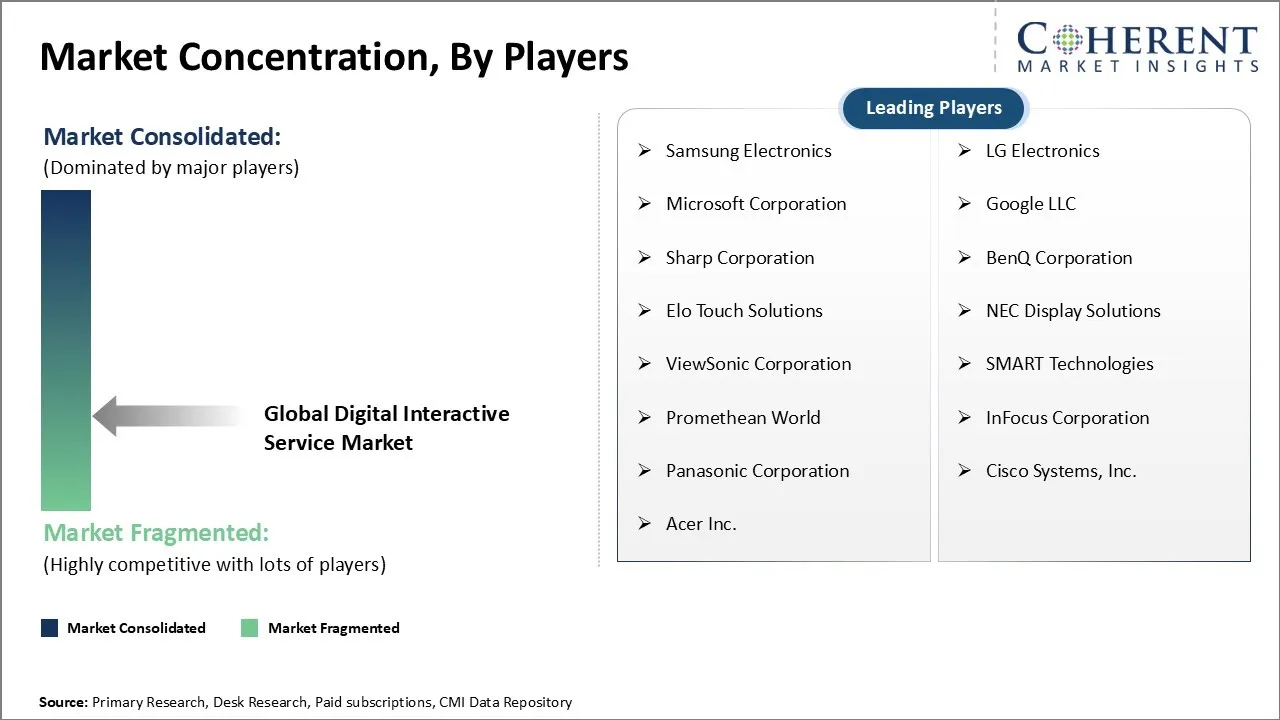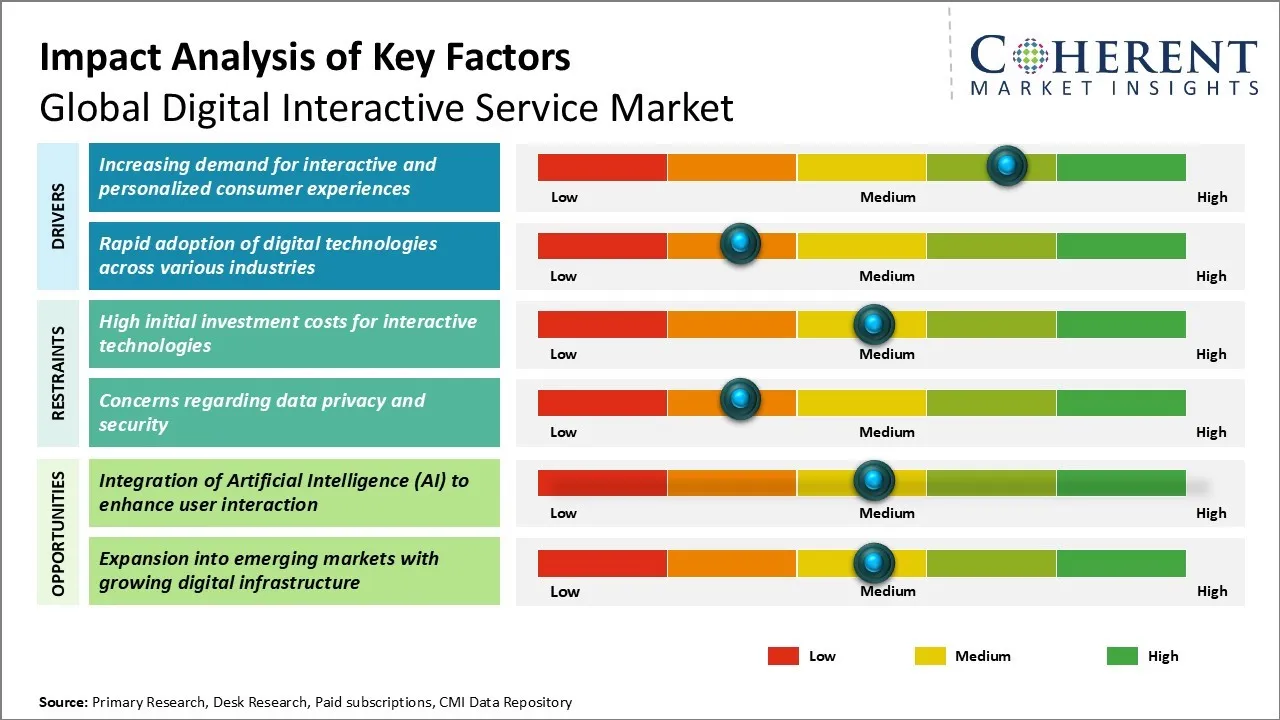The Global Digital Interactive Service Market is estimated to be valued at USD 1.76 Bn in 2025 and is expected to reach USD 2.68 Bn by 2032, exhibiting a compound annual growth rate (CAGR) of 6.2% from 2025 to 2032.
Key Takeaways of the Global Digital Interactive Service Market:
Market Overview:
The market has been witnessing steady growth over the past few years driven by increasing adoption of smartphones and growing penetration of internet across the world. Many businesses are leveraging interactive digital platforms to enhance customer engagement and experience. Advancements in technologies, such as artificial intelligence and machine learning, are also supporting market growth.
Display Type Insights - Interactive Kiosk Segment Leads Due to Convenience
In terms of display type, the interactive kiosk segment is expected to contribute the highest share of 35.2% in the market in 2025 owing to the convenience and cost savings they provide end users and businesses. Allowing customers to access information, make purchases, check in for travel, or manage accounts on their own time has resonated strongly. As digitalization increases expectations for self-service options, kiosks have proliferated in locations like airports, shopping centers, hotels, and quick service restaurants.
Their versatility is a major driver of growth. Kiosks can be customized for nearly any purpose, from ticketing to bill payment to assembling custom orders. This has supported applications in transportation, retail, healthcare, and many other areas. Touchscreens allow for intuitive interactions that feel consumer-friendly compared to older button-driven machines. As technology improves, kiosks are taking on more complex tasks. Some even feature VR/AR capabilities for virtually “trying on” products.
An important factor is the labor and space savings achieved. Kiosks reduce waiting lines and free up staff for more valuable tasks. They require minimal floor space and real estate costs compared to building additional service counters. For expanding businesses, kiosks provide a scalable way to add capacity without increasing the size of facilities or payroll. Overall, interactive kiosks have emerged as the most user-friendly and multipurpose digital display type.
Application Insights – Retail Segment Leads Due to the Optimization of Store Operations
In terms of application, the retail segment is expected to contribute the highest share of 31.6% in the market in 2025 due to experiential benefits for customers and optimization of store operations. The retail sector has been a primary driver of growth for interactive services. Digital displays and kiosks enhance the shopping experience by engaging customers with product demos, wayfinding, and educational content. This builds excitement and encourages longer browsing sessions. It also facilitates omnichannel experiences as customers can learn about products online and make purchases in physical stores.
For retailers, interactive screens optimize floor space and associate resources. Well-placed kiosks and digital signage allow self-checkout or sampling without needing separate staffed tables or displays. Dynamic content keeps marketing fresh and relevant to local stores. Inventory management is streamlined with real-time updates of product availability shown digitally.
Evolving consumer preferences, such as the experience economy, place greater importance on immersive in-store activities. Interactive technology satisfies this demand while simultaneously improving operational efficiency. Multi-touch, gesture controls make engagement intuitive. Many retail displays now incorporate artificial intelligence for personalized recommendations too. As retail shifts increasingly to integrated physical-digital models, interactive services will remain crucial for customer relationships and business optimization.

To learn more about this report, Request sample copy
North America Digital Interactive Service Market Trends
North America is expected to dominate the digital interactive service market, holding a share of 38.7% in 2025. The dominance can be attributed to factors such as robust digital infrastructure, widespread smartphone and internet penetration, and early adoption of new technologies. This region houses technology giants that are at the forefront of innovations in interactive services and platforms. Advanced technological capabilities along with supportive government policies have enabled North American companies to establish a strong foothold in this market.
Asia Pacific Digital Interactive Service Market Trends
The Asia Pacific region, holding a share of 27.3% in 2025, is expected to exhibit the fastest growth, driven by a rapidly developing digital ecosystem in major countries. Countries like China and India boast huge populations with rising disposable incomes and digital skills. Significant government investments are enhancing digital connectivity while creating an environment conducive for both international as well as local interactive service providers.
Digital Interactive Service Market Outlook for Key Countries
U.S. Digital Interactive Service Market Trends
The U.S. digital interactive service market continues to thrive due to its well-established technological ecosystem, significant investments in research and development, and a culture of innovation among key industry players. Companies like Google, Microsoft, and Cisco are at the forefront, pioneering new applications in interactive kiosks, AI-driven customer engagement platforms, and cloud-based interactive solutions. The widespread adoption of interactive technologies in retail, corporate environments, and education has further fueled market expansion. Additionally, the U.S. government and private enterprises actively support digital transformation initiatives, enhancing the adoption of interactive services across industries.
China Digital Interactive Service Market Trends
The China digital interactive service market is experiencing rapid growth, driven by the government’s widespread digitization programs and a strong emphasis on emerging technologies such as AI, 5G, and IoT. Companies like Alibaba, Tencent, and Huawei are leading the market by investing heavily in AI-powered chatbots, interactive digital signage, and smart city infrastructure. The country’s thriving e-commerce sector and advanced payment solutions have also increased the demand for interactive services in retail and financial services. Additionally, China’s emphasis on smart manufacturing and automation is propelling the use of interactive services in industrial settings, making the country a key player in global digital interactivity.
India Digital Interactive Service Market Trends
India has emerged as a major hub for digital interactive services, fueled by a vibrant startup culture and a cost-effective approach to technology development. Companies, such as Tata Consultancy Services (TCS), Infosys, and Zoho, are developing interactive solutions that cater to both domestic and international markets. With growing digital adoption across sectors like education, healthcare, and fintech, Indian firms are creating AI-driven customer support systems, interactive learning platforms, and virtual assistants at affordable price points. Government initiatives such as Digital India and increasing smartphone penetration have also accelerated the adoption of digital interactive services, positioning India as a key player in the market.
U.K. Digital Interactive Service Market Trends
The U.K. digital interactive service market benefits from strong technology adoption across industries, particularly in retail, entertainment, and finance. Leading companies, such as BT Group, Sage Group, and ARM Holdings, are unlocking new opportunities by integrating AI-driven voice assistants, smart kiosks, and immersive digital experiences into business solutions. London’s fintech and creative industries have also played a key role in driving digital interactivity, with companies such as Revolut and Monzo enhancing interactive banking experiences. The U.K.’s strong regulatory framework for digital transformation, along with widespread connectivity and a high-tech workforce, ensures continued innovation and expansion in this market.
Germany Digital Interactive Service Market Trends
The Germany digital interactive service market remains robust, backed by technological expertise in the automotive and manufacturing domains. Companies, such as Siemens, Bosch, and SAP, are investing in interactive solutions for smart factories, automotive displays, and enterprise digital transformation. The country’s Industry 4.0 initiatives are accelerating the adoption of interactive industrial solutions including touch-based control panels, AI-powered virtual assistants, and digital twins. Furthermore, Germany’s strong commitment to data security and privacy regulations, along with its leadership in precision engineering and automation, makes it a key market for advanced interactive technologies, especially in the B2B sector.

Get actionable strategies to beat competition: Request sample copy
Key Developments:
Top Strategies Followed by Global Digital Interactive Service Market Players
Emerging Startups – Digital Interactive Service Industry Ecosystem
Sustainable Solutions: The push for sustainable digital solutions is transforming how interactive services integrate with energy-efficient technologies. Companies such as E Ink Holdings develop low-power electronic paper displays, enabling energy-efficient interactive signage and e-readers with minimal environmental impact. Meanwhile, ViewSonic and LG are pioneering solar-powered and eco-friendly interactive display solutions to reduce carbon footprints in retail and corporate environments.
Digital Interactive Service Market Report Coverage
| Report Coverage | Details | ||
|---|---|---|---|
| Base Year: | 2024 | Market Size in 2025: | US$ 1.76 Bn |
| Historical Data for: | 2020 To 2023 | Forecast Period: | 2025 To 2032 |
| Forecast Period 2025 to 2032 CAGR: | 6.2% | 2032 Value Projection: | US$ 2.68 Bn |
| Geographies covered: |
|
||
| Segments covered: |
|
||
| Companies covered: |
Samsung Electronics, LG Electronics, Microsoft Corporation, Google LLC, Sharp Corporation, BenQ Corporation, Elo Touch Solutions, NEC Display Solutions, ViewSonic Corporation, SMART Technologies, Promethean World, InFocus Corporation, Panasonic Corporation, Cisco Systems, Inc., and Acer Inc. |
||
| Growth Drivers: |
|
||
| Restraints & Challenges: |
|
||
Uncover macros and micros vetted on 75+ parameters: Get instant access to report

Discover market dynamics shaping the industry: Request sample copy
Global Digital Interactive Service Market Driver - Increasing demand for interactive and personalized consumer experiences
With advancements in digital technologies, consumers are having access to a plethora of options to engage with brands and services. They have become more demanding and want their individual needs and preferences to be understood by companies. The traditional one-size-fits-all approach is no longer working. Consumers today want personalized experiences at every touchpoint which is tailored to their unique requirements. Brands have started realizing this changing behavior and are leveraging technologies like artificial intelligence, machine learning and advanced analytics to gain deeper customer insights. They are using these insights to offer highly customized and interactive experiences.
For example, e-commerce platforms are recommendation engines that suggests products based on a consumer's past purchases and online behavior. Streaming services provide playlists tailored to individual interests and listening patterns. Banks are offering services like account monitoring and notifications customized for account activity. Many consumer brands have interactive websites and apps which engage consumers through quizzes, surveys, polls, etc. and collect feedback to enhance personalization. Even larger B2B companies are moving in this direction to better serve their enterprise customers. Interactive digital experiences allow consumers to have a dialogue with brands and get instant, contextually relevant responses to their queries or requirements.
This demand for personalized experiences has also grown tremendously due to the popularity of social media platforms. People have increasingly grown accustomed to tailor made experiences online. Social media companies have also taught brands the power of understanding individuals at a granular level. Unless companies deeply analyze each consumer's unique preferences, behaviors and needs, it is difficult to engage them in today's interconnected digital world. Interactive and personalized experiences are therefore crucial for not just acquiring new customers but also retaining the existing ones in this highly competitive environment. Digital technologies provide immense opportunities for companies to build these kinds of engaging experiences at scale.
Global Digital Interactive Service Market Challenge - High initial investment costs for interactive technologies
One of the key challenges faced in the global digital interactive service market is the high initial investment costs associated with adopting new interactive technologies. Developing high-quality, immersive interactive digital experiences often requires investing in advanced technologies such as virtual and augmented reality platforms, interactive kiosks, gesture and motion tracking systems, and other tools that enable enhanced user engagement and personalization. However, setting up the necessary infrastructure and acquiring these technologies involves substantial upfront capital expenditure. For many organizations, especially smaller companies and startups, allocating large capital budgets to unproven interactive initiatives is risky without any assurances of generating a positive return on investment. The high costs act as a barrier to entry for new interactive service providers and can also limit the scope of implementation within organizations with constrained budgets. Widespread adoption of new interactive technologies may be slowed down as businesses closely scrutinize investment decisions in such capital-intensive areas.
Global Digital Interactive Service Market Opportunity - Integration of Artificial Intelligence (AI) to enhance user interaction
One of the significant opportunities in the global digital interactive service market lies in leveraging artificial intelligence to enhance user interactions. AI has the potential to transform how people engage with digital products and services by making interactions more intuitive, contextual and personalized. As AI systems gather more data through interactions, their capabilities improve continuously. Service providers can integrate AI throughout the product experience - from using computer vision and natural language processing to understand user behavior and preferences, to dynamically personalizing content flow, recommendations and navigation based on real-time user signals. AI assistants powered by conversational interfaces also allow creating entirely new interactive paradigms. As AI algorithms advance further, they will facilitate highly personalized and immersive interactions. This allows digital services to deliver superior user value, drive higher engagement levels and open up new monetization possibilities through AI-powered personalization at scale.
Share
Share
About Author
Monica Shevgan has 9+ years of experience in market research and business consulting driving client-centric product delivery of the Information and Communication Technology (ICT) team, enhancing client experiences, and shaping business strategy for optimal outcomes. Passionate about client success.
Transform your Strategy with Exclusive Trending Reports :
Frequently Asked Questions
Joining thousands of companies around the world committed to making the Excellent Business Solutions.
View All Our Clients